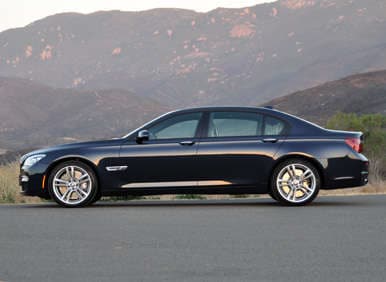Recent Articles
Popular Makes
Body Types
2013 BMW 7 Series Luxury Sedan Road Test and Review

Drive around the coastal regions of Los Angeles, and it won’t take long to figure out that denizens of the City of Angeles choose cars as accessories, not as mere methods of transportation, and that the badge on the back establishes pecking order. The up-and-comers start out with the entry-level luxury car, a lease special in some non-metallic shade of paint, and rocking a set of stock 17s. Often, the model series designation will be removed from the back of the car, in an effort to hide the fact that it’s a 320i, or a C250, or an IS250.
The heavy-hitters pay cash and roll in the most expensive version of whatever they’ve chosen to reflect their stature, frequently equipped with after-sale modifications lest their black ultra-luxury sedan with deep-tinted glass be confused with all of the other black ultra-luxury sedans with deep-tinted glass cruising the streets of the wealthier L.A. enclaves. You never see the badges removed from these cars, encrusted as they are with “M” or “AMG” lettering combined with big numbers like “760” or “S65.”
Among the machines favored by the heavy-hitters, my favorite has long been the Mercedes-Benz S-Class. Distinctive from the C-Class and E-Class, the S-Class achieves something the Audi A8, which looks just like an A4 or an A6, does not. The S-Class exhibits zero compromise, unlike the Jaguar XJ. And the S-Class doesn’t overtly share components with mainstream models, like the Lexus LS. The only car that comes close to the S-Class in terms of appeal, in my opinion, is the BMW 7 Series, and this is a relatively recent development.
Because the 7 Series is updated for 2013, and because a redesigned S-Class is due in showrooms soon, I figured I’d better get reacquainted with the big BMW, so I borrowed a couple of look-alikes in the form of the 750Li and 760Li, and then spent a week driving around L.A. pretending to be something I most certainly am not.
2013 BMW 7 Series Road Test and Review
The least expensive 2013 7 Series model is the 740i with a regular wheelbase, at $74,525 including the $925 destination charge. The most expensive 2013 7 Series model is the 760Li with an extended wheelbase, at $143,325 including destination and a $1,700 gas-guzzler tax. In between these two extremes, buyers can select the 740Li ($78,525), the ActiveHybrid 7 ($85,225), the 750i ($87,725), the 750Li ($91,425), and the Alpina B7 ($129,420).
I sampled the 750Li and 760Li, each painted Carbon Black Metallic, a paint color offered exclusively with the optional M Sport Package. My 750Li test car added the Cold Weather Package, Driver Assistance Package, Executive Package, Lighting Package, Luxury Rear Seating Package, and Rear Entertainment Package. Additional upgrades included 20-inch double-spoke wheels, a Bang & Olufsen sound system, integral active steering, and BMW carpeted floor mats for a total of more than $114,000.
My 760Li test car came equipped with the M Sport Package, Platinum/Black full Merino leather, Bang & Olufsen sound, a rear-seat entertainment system, Active Cruise Control with Stop & Go and Active Driving Assistant, Night Vision with Pedestrian Detection, and BMW carpeted floor mats. The window sticker equaled nearly $158,500.
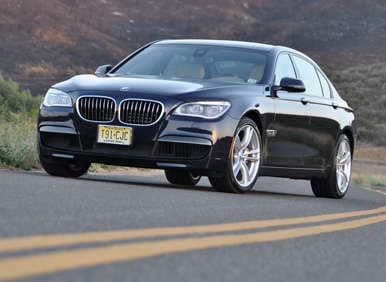
2013 BMW 7 Series Road Test and Review: Design
- Restyled grille and headlights
- New exterior mirrors with LED signal indicators
- Taillights have darker lenses
- Optional adaptive LED headlights
- Revised ambient lighting for cabin
I can understand if one might find the 2013 7 Series unappealing. The traditional dual-port grille flanked by lidded headlamp “eyes” underlined by a lower air intake that neither smiles nor frowns gives the 7 Series a serious, determined look entirely in character with its Germanic design and engineering execution. Yet I find this modern 7 Series more conservative, more traditional, and more attractive than the 2001-2008 version, even if it’s harder to distinguish from a lower-priced 5 Series. In any case, BMW buyers can tailor a 7 Series through various paint colors, interior trims, and wheel designs, making it easy to end up with a Carbon Black Metallic beauty equipped with 20-inch double-spoke wheels like the car shown above.
Inside, the new 7 Series represents a clear upgrade over a 5 Series in terms of design and materials, though to be fair, the 2014 version of the Five is upgraded in many respects. As might be expected of a vehicle wearing a six-figure price tag, quality is in evidence nearly everywhere an occupant looks and touches, with a few exceptions.
For example, the glove box latch is rendered in black plastic. The glove box door should be an uninterrupted leather panel opened using a silver push-button located on the dashboard, similar to that used to open the wood panel that hides the DVD player. Speaking of that wood panel, it opens with the push of a button, but requires manual closing. Even a lowly previous-generation Toyota RAV4 offered one-touch close for a similar design. I also found that cost was pulled out of the car in the back seat, where sticky air vents proved difficult to adjust, the rear center console liner felt inexpensive, and on the 760iL, dual lighters clicked into place with a cheap sound and feel. Given that many 760Li owners ride rather than drive, this strikes me as bad policy.
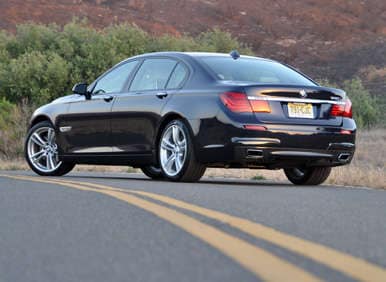
2013 BMW 7 Series Road Test and Review: Comfort and Cargo
- Updated seat designs
- Additional sound deadening material
- More rear seat headroom for Li models
- Optional rear comfort seats with individual adjustment
- Hands-free trunk opening
Both of my test cars were long-wheelbase examples equipped with active front seats and individual rear comfort seats, so it goes almost without saying that comfort proved outstanding. I can also attest as to the effectiveness of the climate control system’s air filtration system. We passed a flattened skunk on a country road, and didn’t get a single whiff of it inside the 7 Series.
A word of warning, however, to folks who do choose to go with the long-wheelbase “Li” models. Those rear doors swing wide and fast, and the framing for the traditional Hofmeister kink hit me in the chest more than once. Plus, the doors are a clear and present danger to surrounding cars in a parking lot, but then, if you’re buying a 7 Series, that’s the valet’s problem, not yours. I did notice, however, that the 7 Series models’ doors lack traditional detents. You can open them to whatever aperture is appropriate and they will stay in place unless you adjust them. How thoughtful.
This year, BMW offers a new hands-free trunk opener in conjunction with Comfort Access, and it works well to swing the lid open when your arms are full of children and parcels. The 7 Series offers a maximum of 17.7 cu.-ft. of beautifully finished cargo capacity, which is plenty.
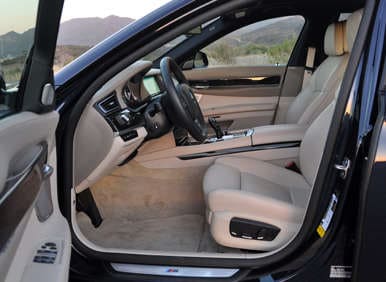
2013 BMW 7 Series Road Test and Review: Features and Controls
- Next-generation iDrive controller and displays
- Optional Bang & Olufsen surround sound audio system
- Optional rear-seat entertainment system with individual tablet-style display screens and iDrive system controller in rear center console
- New mobile office technology
Perhaps I’ve acclimated myself to modern BMWs over the years, but I just don’t find them to be all that confusing anymore, especially in contrast to the mess that is Cadillac’s CUE technology. Even the top-of-the-line 760Li provides two rows of hard keys to control primary climate and audio controls, leaving the oft-maligned iDrive controller to be used as a secondary device for navigation and deeper-dive control of the car’s various technologies.
The good news is that the newest version of iDrive is much simpler and intuitive, and employs a wide display screen with gorgeous graphics. The bad news is that iDrive advancements render the Seven’s silly joystick gear selector the car’s most significant ergonomic flaw.
As might be expected when a $155,000 luxury sedan shows up in the driveway, my family decided to take a little ride up to Santa Barbara and back. After all, we needed to see if our preschoolers might be satisfied with viewing a Disney classic on the twin “floating” tablet-style rear-seat entertainment screens, and hearing thunderous theatre-quality sound from the 760Li’s outstanding Bang & Olufsen audio system. Naturally, the kids were easily satisfied, as viewing a movie in a moving vehicle remains a novelty for them.
Mom and Dad were satisfied, too, because the 760Li is virtually silent at speed. Aside from some difficulty accessing the seat massaging function through the iDrive menus, the 7 Series is remarkably, and surprisingly, intuitive to use.
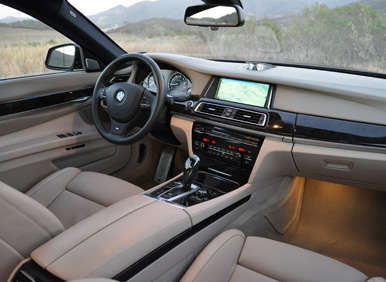
2013 BMW 7 Series Road Test and Review: Safety and Ratings
- Standard Attention Assist technology
- Optional Active Cruise Control gains Stop & Go functionality
This year, the 7 Series is equipped with Attention Assist technology, which is designed to recognize a drowsy driver and then recommend a rest stop, where perhaps a short nap might be in order. Also new for 2013 is Stop & Go functionality for the optional Active Cruise Control system, allowing the 7 Series to come to a complete stop if necessary, and then resume the set speed when it is safe to do so.
One observation relevant to parents who must install child safety seats is that the 7 Series models’ Lower Anchors and Tethers for Children (LATCH) system isn’t easy to use. The lower anchors are particularly difficult to access, or at least they were for my style of forward-facing child seats. But then again, how many 7 Series buyers are hauling kids around in one of these? Not many, I’d wager.
The National Highway Traffic Safety Administration (NHTSA) and the Insurance Institute for Highway Safety (IIHS) typically do not spend their budgets performing safety tests on vehicles that cost this much money. As a result, as this review is written, the 7 Series has not been assessed by either organization, nor is it likely to be in the future.
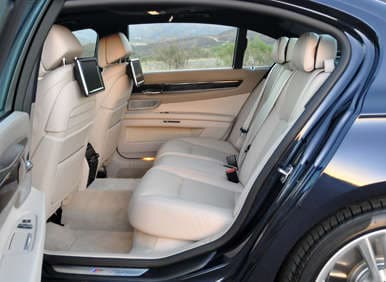
2013 BMW 7 Series Road Test and Review: Engines and Fuel Economy
- New engine for 740i and 740Li
- 750i and 750Li are more powerful and more fuel efficient
- ActiveHybrid 7 gets new powertrain
- Standard 8-speed automatic transmission for all models
- Standard automatic stop/start technology for all models (except 760Li)
- Standard Driving Dynamics Control with ECO PRO technology (except 760Li)
- Standard self-leveling rear suspension
- Optional xDrive for 740Li
BMW has made extensive changes under the hoods of most 7 Series models this year, starting with the 740i and 740Li. These variants receive the same turbocharged 3.0-liter 6-cylinder “N55” engine that is installed in nearly everything the automaker builds. In the 7 Series, it makes 315 horsepower and 330 lb.-ft. of torque, is equipped with automatic stop/start technology, and is bolted to a new 8-speed automatic transmission that is standard for all 2013 7 Series models. BMW also offers xDrive all-wheel drive for the 740Li for the first time.
The ActiveHybrid 7 gets a new gas-electric powertrain that uses the “N55” 6-cylinder engine as its basis. An electric assist motor, a lithium-ion battery, and a modified 8-speed automatic are paired with the turbocharged 6-cylinder, and the ActiveHybrid 7 generates a combined 349 horsepower and 367 lb.-ft. of torque. BMW says this model can travel up to 2.5 miles at speeds up to 37 mph.
More powerful and more fuel efficient than last year, the 750i and 750Li have a twin-turbocharged 4.4-liter V-8 engine that gains Valvetronic technology for 2013, pushing horsepower to 445 and torque to 480 lb.-ft., increases of 45 and 30, respectively. At the same time, thanks in part to automatic stop/start technology, fuel economy rises by 2 mpg across the board, to 16 mpg in the city, 24 mpg on the highway, and 19 mpg in combined driving.
I think it’s cool that the 750Li, which accelerates well into triple-digit territory before you’re entirely sure of what’s happening, and which weighs 4,660 pounds, doesn’t quaff fuel to the degree that it probably should. I averaged 19.1 mpg on my test loop, which involves 1,800 feet of elevation change and plenty of hard charging on twisty two-lane roads, while cycling between Sport, Comfort, Comfort+, and Eco Pro driving modes.
As expected, the 5,015-lb. BMW 760Li did not prove as fuel efficient, yet I averaged 16.2 mpg with an emphasis on highway driving, beating the EPA’s combined estimate of 15 mpg for this model. This, despite dipping regularly into the twin-turbocharged 6.0-liter V-12 engine’s seemingly limitless well of horsepower and torque, and riding a tidal wave of twist measuring 550 lb.-ft. between 1,500 rpm and 5,000 rpm before crashing onto a sandy beach of 535 horsepower at 5,250 rpm. It’s a damned miracle I’ve still got my driver’s license.

2013 BMW 7 Series Road Test and Review: Driving Impressions
Stately and reserved are descriptors commonly reserved for more genteel luxury sedans than those proffered by BMW, but when a 750Li is driven in Eco Pro or Comfort + driving modes, they are apt for the 7 Series. Yet, even with the Driving Dynamics Control knob set to Eco Pro, the 750Li is a responsive car. It takes a little more effort to override the software in terms of throttle application, but this car moves when you want or need it to.
The twin-turbo 4.4-liter V-8 gives the hulking 750Li plenty of muscle, but this car’s acceleration doesn’t produce a shove into the backs of passengers. Deceptively quick, the 750 is such a rock-solid road car that it feels more like you’re going 40 mph when the speedometer indicates 80 mph, which is why the heads-up display (HUD) and its Speed Limit Info system is particularly helpful. I also noticed that HUD illumination brightens and dims with changing lighting conditions, which is great. Unfortunately, polarized sunglasses render the HUD and other interior displays nearly invisible, which is not.
Switch over to Sport mode, and in my opinion, the steering effort becomes too heavy and stiff, and the car’s revs are maintained too high, to be practical. But this mutha sure melts pavement when in Sport mode. On the mountainous portions of my test loop, this big car turned in an unflappable performance, and the steering offers genuine feel, a thrum and vibration almost always missing from electric steering systems. More than any other model in the range, the 7 Series has restored my faith in modern electronically controlled BMWs.
Most 7 Series owners, however, will prefer driving this car in its non-Sport modes, and I actually liked the lighter steering and wafting ride quality with the Driving Dynamics Control set to Comfort. Driven conservatively, the car steps smoothly off the line, and then brilliantly filters unwanted road intrusions from passengers while delivering important information about the street surface and the mechanicals to the driver. These qualities better befit this magnificent car. But when the 750’s new automatic stop/start system kicks in, it sure does so with a lack of refinement. It’s almost rude when reigniting the V-8.
Thus far, I’ve discussed my impressions of the 750Li. The 760Li delivers a nearly identical performance, but with a whole bunch more power and without automatic stop/start technology. The twin-turbocharged V-12 behaves in docile fashion the majority of the time, but if you mat the throttle, it will attempt to divorce the rear axle from the rest of the car. On a remote, vacant straight, I stopped the 760iL, switched to Sport mode, and dropped the hammer. The rear tires mightily struggled to grip the pavement, and second gear engaged like a subductive earthquake.
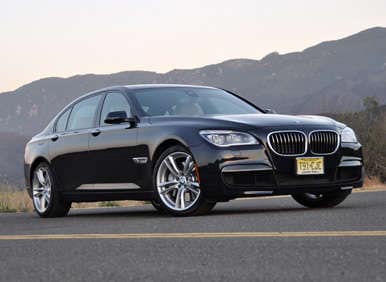
2013 BMW 7 Series Road Test and Review: Final Thoughts
Most of the time, I focus on evaluating the vehicles that most Americans buy in volume, not the ones about which they dream. Luxury car buyers are like pickup truck buyers in that they’ll purchase whatever it is that they require regardless of what I have to say about it. As such, I haven’t spent any time in the current 7 Series since it was redesigned several years ago.
Having now spent a week with the updated 2013 7 Series, I’m prepared to switch my allegiance to the BMW in this rarefied class. For now, anyway.
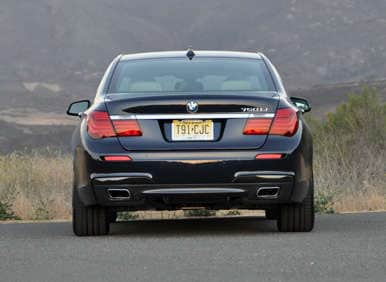
2013 BMW 7 Series Road Test and Review: Pros and Cons
- Impressive blend of power and efficiency
- Superb seating and interior layout
- Best looking 7 Series in a decade
- Amazing performance
- Automatic stop/start rudely re-ignites 750Li’s engine
- Annoying transmission selector operation
- Odd interior functionality oversights
- Rear doors open very wide, very fast
BMW supplied the vehicles for this review
2013 BMW 750Li photos by Christian Wardlaw
